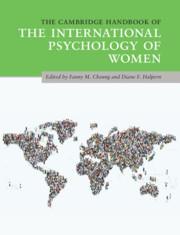Book contents
- The Cambridge Handbook of the International Psychology of Women
- The Cambridge Handbook of the International Psychology of Women
- Copyright page
- Dedication
- Contents
- Figures
- Tables
- Contributors
- Acknowledgments
- Section 1 The Underpinnings of Sex and Gender and How to Study Them
- Section 2 Developmental Perspectives of the International Psychology of Women
- Section 3 Cognitive and Social Factors
- Section 4 Work and Family Issues
- 19 Career Development of Women
- 20 The Psychology of Women in Entrepreneurship
- 21 Women’s Leadership across Cultures
- 22 Occupational Health Psychology and Women in Asian Contexts
- 23 Work–Family Interface and Crossover Effects
- 24 Intimate Relationships
- 25 Contextualizing the Many Faces of Domestic Violence
- Section 5 Inequality and Social Justice
- Section 6 Health and Well-Being
- Epilogue Some Final Thoughts and Take-Home Messages
- Index
- References
23 - Work–Family Interface and Crossover Effects
Exploring for the Effects of Gender
from Section 4 - Work and Family Issues
Published online by Cambridge University Press: 20 July 2020
- The Cambridge Handbook of the International Psychology of Women
- The Cambridge Handbook of the International Psychology of Women
- Copyright page
- Dedication
- Contents
- Figures
- Tables
- Contributors
- Acknowledgments
- Section 1 The Underpinnings of Sex and Gender and How to Study Them
- Section 2 Developmental Perspectives of the International Psychology of Women
- Section 3 Cognitive and Social Factors
- Section 4 Work and Family Issues
- 19 Career Development of Women
- 20 The Psychology of Women in Entrepreneurship
- 21 Women’s Leadership across Cultures
- 22 Occupational Health Psychology and Women in Asian Contexts
- 23 Work–Family Interface and Crossover Effects
- 24 Intimate Relationships
- 25 Contextualizing the Many Faces of Domestic Violence
- Section 5 Inequality and Social Justice
- Section 6 Health and Well-Being
- Epilogue Some Final Thoughts and Take-Home Messages
- Index
- References
Summary
Despite mixed and sometimes confusing results posed by the role of gender in the work-family (W-F) interface, gender research in WF studies cannot be laid to rest. In this chapter we review W-F spillover and crossover literature involving dual earner couples in different cultural contexts – Anglo/European, Asian and Middle Eastern – to identify gendered patterns in spillover and crossover effects experienced by men (husbands) and women (wives). Gender asymmetry continues to be evident in dyadic couple relationships across cultures, especially when one considers crossover effects.
Keywords
- Type
- Chapter
- Information
- The Cambridge Handbook of the International Psychology of Women , pp. 329 - 341Publisher: Cambridge University PressPrint publication year: 2020
References
Suggested Readings

Ujvala Rajadhyaksha is Associate Professor in the College of Business at Governors State University in the United States. She has held full-time faculty positions at Saint Mary’s College, Notre Dame, Indiana, the Indian Institute of Technology, Bombay and the Indian Institute of Management, Calcutta,. Her research interests include work and family issues, gender issues and intercultural and cross-cultural issues in management. She has been a collaborator on three large-scale cross-cultural W–F studies. Her research has been published in Human Relations, Sex Roles, Journal of Business Ethics, Journal of Management Education, and Applied Psychology and Organizational Dynamics. Ujvala deeply identifies with the topic of dual-earner couples with her personal experience of juggling work and life in tandem with her husband across three countries and multiple cultures. Her doctoral dissertation was a study of the work–family conflict of dual-career couples in India across the work–family life cycle. One of her thesis publications was nominated for the Rosabeth Moss Kanter Award for Work and Family Research in 2001. Ujvala was born and raised in Mumbai. She attended college and graduate school in India. She has lived and worked in India, China, and the United States, and spent a semester in Canada on the Shastri Indo-Canadian Fellowship.

Burcin Baskurt has a PhD in Social and Organizational Psychology from Koç University, Istanbul. She earned her BA in Sociology at Bogazici University and her MA in Comparative Studies in History and Society at Koç University. Her doctoral research concentrated on career decisions of young people in Turkey and antecedents of career change intentions of young employees. Her main areas of research include interrelations between gender, work, and education. She has been working in various national and international research projects, including career tracks of social sciences and humanities PhD graduates, success definitions of entrepreneurs, positive development of early adolescents, and fears of women and men in leadership positions. She has journal publications, book chapters, and conference proceedings on these different topics. She received the Graduate Studies Excellence Award from Koç University and the Crosby-Spendlove Award from SPSSI in support of feminist perspective and social justice. Baskurt was born in Istanbul, where she attended college and graduate school. She spent a semester in her senior year in Michigan. She has been living in London since June 2018.



